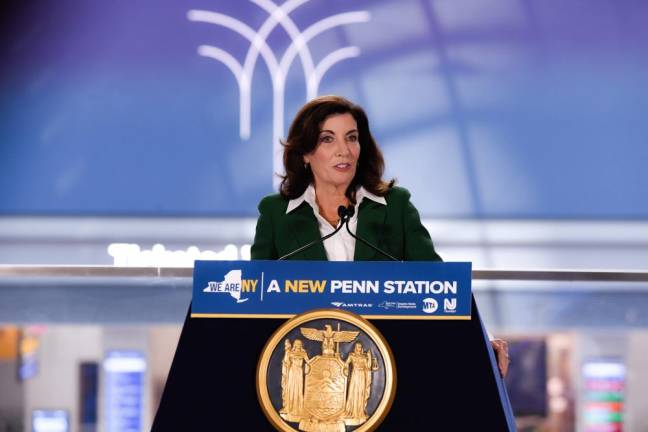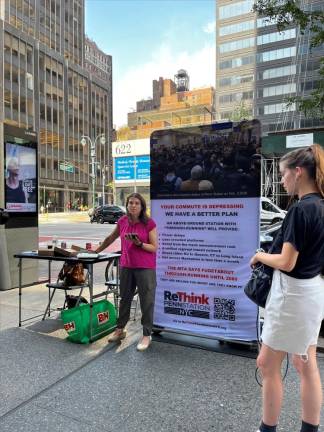Hochul Pushes Ahead on Penn Station Plan
Empire State Development Corporation unanimously approves project amid objections from community boards
The Hochul administration pressed forward against continued community resistance with its plan to renovate Penn Station and redevelop its neighborhood, saying there was only a narrow window to secure billions in funding from the federal government for improvements that will ripple out far beyond Eighth Avenue and 33rd Street.
“This project has not only great benefits for the city of New York, but certainly the entire metropolitan region,” declared Kevin S. Law, chair of the state’s Empire State Development Corporation, which unanimously approved the project Thursday. “So it’s very exciting.”
Law, a Long Island real estate developer appointed by Governor Kathy Hochul last year to chair the Development Corporation, said the ESD had received 110 statements and comments from the public in the days before the vote, half of them in favor.
Supporters included the construction trades, real estate organizations and rail commuters who suffer the unpleasant passage through the dingy and cramped Penn Station.
Residents around the station continue to oppose the plan, however. Both of the Manhattan Community Boards representing the area, Boards 4 and 5, filed objections in advance of the vote to the cost, scale, dislocation and financial uncertainties of the project.
“We note that over the course of the past two years, the chorus of opposition against the plan has grown louder,” wrote Layla Law-Gisiko, chair of the land use, housing and zoning committee of Community Board 5, “and includes all major New York publications, advocacy groups, good government groups, residents, businesses, city state and congressional elected officials, to name a few.”
Commercial Towers
Under the plan, Hochul proposes to let private developers build ten commercial towers around the station and tap the increased value of this construction to partially pay for the renovation of Penn Station and improvements to the neighborhood.
A few days before the vote the governor announced agreement with Mayor Eric Adams on how to divvy up the increased revenue these developments would throw off.
The development properties, half of them controlled by one company, Vornado Realty Trust, would be taken off the city’s property tax rolls and would instead make payments in lieu of these property taxes to the state, know as PILOT payments.
The state would then pay to the city an amount equal to the real estate taxes it currently receives on the properties, plus a 3 % annual increase, Hochul and Adams said.
The rest of the PILOT money, an amount negotiated with Vornado and other developers based on the increased value created by the new construction, would be used by the state to pay for improvements in sidewalks and public spaces, renovation of subway stations and a portion of the state’s share of the cost of renovating Penn Station.
Federal Infrastructure Funds
At the meeting, officials said there was considerable urgency to get the project underway to tap billions in federal infrastructure funds to cover half the cost of renovating Penn Station, which is owned by Amtrak.
Critics have attacked the plan, saying it won’t produce nearly enough revenue to cover the state’s costs. Law said that was never the goal.
“One of the questions I get often is why do we have to do this project now,” Law said to the ESD’s staff.
“There will be a unique moment,” replied Holly Leicht, executive vice president for Real Estate Development & Planning. “The availability of federal funding at levels that haven’t been seen at least in decades, if ever, and we have a very small window to claim our part of that new pot of money.”
She said that to apply for those federal money the state need to show a viable plan for its share. Capturing value from new development was a “tried and true” technigue and more reliable than annual appropriations from the legislature.
“This is how we’re proving that we can pay our local share. Uh, it’s much more predictable and certain than, uh, navigating the annual budget process at the legislature. So it’s a very important component and the time is now for us to be applying for that money.”
Midterm Elections
Officials expressed concern that the money could dry up if the Congress turns to Republican control after the midterm elections.
Leicht also said there would be an ideal window for track and platform work on Penn station between when some Long Island Rail Road Trains are diverted to Grand Central Terminal, reducing load at Penn Station, and passengers start arriving from four new stations being built in the Bronx.
“That’s a moment when it’ll be easiest to take some tracks offline because not as many trains are coming in and they’ll be able to do this work with minimal disruptions,” she said. “And that again is a very short window.” Leicht also sought to answer another question Law said he was frequently asked about the project, which would by 2044 create some of the tallest new towers in Manhattan:
“Is there really a need for more office space in Manhattan given the fact that COVID has encouraged a lot of people to work remotely?”
“It’s certainly a volatile moment right now,” Leicht acknowledged. “However, what we are seeing in the trend is what has been called a flight to quality. There is still very strong demand for new class A office space. Companies are looking to configure their office space differently to accommodate both post-COVID protocols and also to accommodate just a different, more flexible way of working. So in both Hudson Yards and in East Midtown we are seeing still strong demand for new class A office space.”
Converting Buildings
What will likely be effected, she suggested, will be older buildings, often categorized as class B and Class C offices. Converting some of those buildings to other uses, such as apartments, “is going to have to be a priority that goes hand in hand with the demand for the new class A office space,” she said.
She noted the project will stretch out for as much as 80 years and that all the new office space will be absorbed.
“I think we all believe you don’t bet against the future of New York city.”
The plan does include giving tax breaks to Vornado and other developers to encourage their investments. Critics say they believe these breaks could come to $1.2 billion. The ESD did not cite a number, saying nothing was yet agreed to.
But they promised to cap the tax breaks at the same level as those grante for the construction of Hudson Yards to the west. Currently, those breaks are a reduction of 20%.
Vornardo’s CEO, Steven Roth, normally a Republican donor, has made major contributions to Hochul and her Lieutenant Governor, Antonio Delgado.
The approval of the project by ESD is not the end of the story. The state’s Public Authority Control Board, composed primarily of representatives of the legislature, must vote to approve the financial plan between the city and the state.
“Given that the role of the PACB is to evaluate the financing of the project,” a group of Manhattan legislators wrote, “It is essential that it has all financial information prior to this matter being brought before them for a vote.”
State Senator Liz Kreuger, a critic of the project, said through her spokesman that she “still has significant concerns regarding inadequate accounting of the financials for the project, which has not yet been made publicly available, and will be discussing the issues with her Senate Colleagues.”

